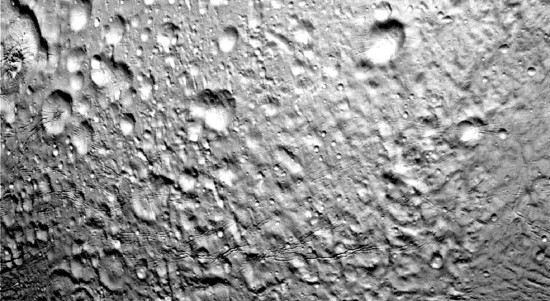Feb 21, 2014
This small moon is said to be covered with powdery snow.
Enceladus was one of the Gigantes, or Titans, who were overthrown by Zeus and his minions. It is perhaps an ironic name, since it is a tiny world only 494 kilometers in diameter. Its gravitational acceleration is about 10% of Earth’s 1g field, so a long jump by Mike Powell could put him into an indefinite orbit. However, he would have to contend with a temperature of -261 Celsius. Enceladus was discovered by William Herschel in 1789.
On March 2, 2012 the Cassini-Solstice spacecraft flew by Saturn’s moon Enceladus at a distance of 74 kilometers, the closest it will come until October 28, 2015 when it will skim by at only 49 kilometers. Cassini will again pass over the “superheated geysers” erupting from the south polar region of this frozen moon. During the 2012 encounter, ultraviolet imaging at high resolution detected “icy particles” coming from the vents and plumes.
By comparing global color patterns in both infrared and ultraviolet frequencies and measurements of surface layer thicknesses, it was determined that ice particles form a pattern as they fall back onto the moon. According to NASA scientists, such deposits indicate that the plumes are relatively long-lived, perhaps millions of years.
Plume deposition models reveal that ice accumulates on Enceladus very slowly, less than a thousandth of a millimeter per year. For 100 meters of ice to form from particle fallback, it would take millions of years. For mission team members, it is an important idea, because it suggests that the underlying heat source needed to activate the plumes, and keep liquid water under the crust liquid, would also require long ages of time. Also, without constant replenishment from Enceladus, they speculate that Saturn’s E-ring (formed by plume particles) would dissipate in hundreds of years.
Mission scientists conclude that hot liquid water beneath the surface must be responsible for the plumes, because solar radiation and internal heating are the only energy sources that are allowed in their theories. Solar heating is completely inadequate because the moon is so far away from the Sun, so “tidal kneading” from Saturn might be responsible.
However, the same kind of activity that was discovered between Jupiter and its moons (particularly Io) has been found connecting Enceladus with Saturn: an ultraviolet “footprint” in Saturn’s auroral oval. During the August 11, 2008 flyby, Cassini’s plasma sensors found ion and electron beams propagating from Saturn’s northern hemisphere. So, the vapor plumes from Enceladus flow as an electric current to Saturn. Since electricity does not flow in one direction the one-way connection cannot be correct, so how is the electricity moving between Enceladus and Saturn?
Conventional theories assume that the Universe is electrically neutral, so when observational evidence confirms electrically active plasma for instance, localized phenomena no matter how improbable are invoked. Tidal forces and “cryo-volcanoes” are presented as the cause for the activity seen on Enceladus and the evidence for electric circuits is ignored.
Saturn is connected with the Sun and the Sun is connected with the Milky Way. The Milky Way is probably connected with the Local Group and then with the Cluster and so on and so on. That idea is what forms the basis of Electric Universe Theory. An electrical interaction between Saturn and its moons means that they are charged bodies and are not electrically neutral. Saturn exists in a dynamic electrical relationship with the Sun and with its orbiting family.
Stephen Smith













